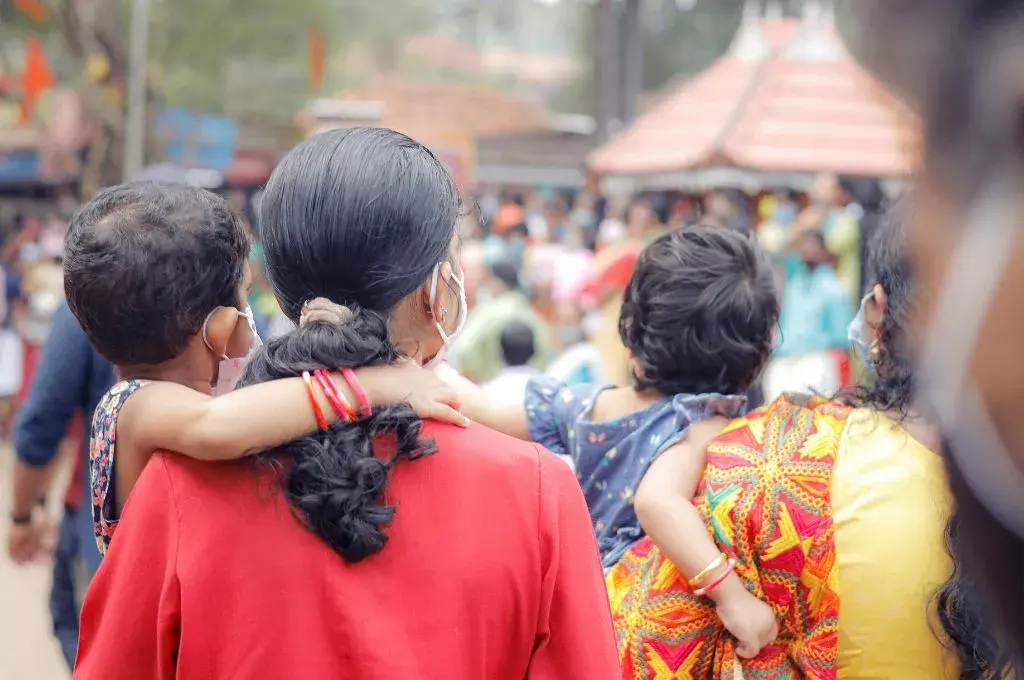Priyali Sur, an independent journalist who is eight months pregnant, recently launched a petition to include pregnant women in India’s COVID-19 vaccination drive. Her interviews with pregnant women and lactating mothers highlight their struggles. Tejaswini, an expectant mother from Bangalore, has been unable to go for her antenatal check-up for more than a month due to a lack of transportation facilities, as well as her fear of contracting COVID-19 at the center. She and her husband are unsure about how to manage the situation.
Tejaswini is not the only mother-to-be facing this dilemma. An analysis of the Health Management Information System (HMIS) data by the Population Foundation of India revealed that during the national lockdown (April-June 2020), there was a 27 percent drop in pregnant women receiving four or more antenatal check-ups and a 22 percent fall in prenatal services when compared to the same period in 2019. Furthermore, there was a 28 percent decline in institutional deliveries.
It is estimated that in India, there are approximately 50 million pregnant women and lactating mothers each year. Despite this, pregnant women and lactating mothers were initially excluded from the Ministry of Health and Family Welfare‘s COVID-19 vaccine advisory due to the lack of data from clinical trials about the effect of the vaccine on them. It was only on May 19th, 2021—on the recommendation of the National Immunisation Technical Advisory Group (NTAGI)—that lactating mothers became eligible for the vaccine. The case of pregnant women is still under consideration as of June 2nd, 2021.

Given the risk posed by COVID-19 to maternal health and well-being, there is a need to immediately classify pregnant women as ‘high risk’ and include them in the vaccination drive.
What does existing evidence say?
The World Health Organisation (WHO) has stated that pregnant women or recently pregnant women who are older, overweight, and have pre-existing medical conditions such as hypertension and diabetes, appear to be at a higher risk of experiencing severe COVID-19. A study published by Lancet found that pregnant women, especially in the second half of pregnancy, were at an increased risk of complications (severe pneumonia, hospitalisations, admission to intensive care unit, and so on) compared to non-pregnant women of the same age. The Centers for Disease Control and Prevention (CDC) in the United States and the Joint Committee on Vaccination and Immunisation (JCVI) in the United Kingdom have both classified pregnant women as vulnerable groups who face an increased risk of severe illness from COVID-19.
The number of maternal deaths in India is also expected to have increased by 18 percent in 2020 as a result of the COVID-19 pandemic response—the highest in South Asia.
Another UNICEF study that examined the direct and indirect impacts of COVID-19 on maternal and child mortality revealed that the number of stillbirths is predicted to increase across South Asia, with the largest increase (10 percent) expected in India. Similarly, the number of maternal deaths in India is also expected to have increased by 18 percent in 2020 as a result of the COVID-19 pandemic response—again the highest in South Asia. Further, child mortality is expected to increase in India by 15.4 percent and neo-natal mortality by 14.5 percent.
It is for these reasons, along with the findings from the studies conducted by the CDC in the US, that the Federation of Obstetric and Gynaecological Societies of India (FOGSI) has recommended that obstetricians, gynaecologists, and women’s health care providers should administer the COVID-19 vaccine to pregnant and breastfeeding women, with preparations to manage adverse events. Despite the recommendations of FOGSI and NTAGI, the government has opened up the vaccination drive only to lactating mothers and not pregnant women. Additionally, no structured mechanism to monitor adverse events for lactating mothers has been put in place.
Procuring mRNA vaccines and speeding up approval process
To ensure timely protection of pregnant and lactating mothers, the Centre should classify them as a vulnerable group, as has been done in other countries. Countries such as the United States, United Kingdom, and Malaysia have emphasised administering mRNA vaccines such as Pfizer and Moderna for pregnant women and lactating mothers. This is due to the availability of data and information on the post-vaccination effects and efficacy of the mRNA vaccines on pregnant and lactating mothers from across the globe. Furthermore, as these vaccines can be refrigerated at 2-4 degrees centigrade and stored for up to a month, India should consider procuring these vaccines on a priority basis for this group.
Work that needs to be done on the ground
1. Communication
The National Expert Group on Vaccine Administration for COVID-19 (a task force dedicated to framing vaccination guidelines) or the MoHFW needs to develop standard operating protocols to spread awareness about the benefits and side effects of the vaccine on pregnant women and lactating mothers. This education needs to happen not just among women themselves, but also among their family members. It is imperative to ensure that informed consent is taken before administering the vaccines. For this purpose, Anganwadi centres and ASHA workers should be involved to drive the communication and messaging.
2. Operationalisation
Using existing Pradhan Mantri Matru Vandana Yojana (PMMVY) data on pregnant women and lactating mothers from poorer socio-economic backgrounds, either relief camps with doctors and/or public health care centres (PHCs) can be utilised to administer vaccines to these groups at specified periods. Importantly, these PHCs should register any side effects of vaccination on these women and monitor their health.
Additionally, the Co-WIN portal should provide an option to classify or identify as a pregnant woman or lactating mother and they should be prioritised while providing slots. Separate timings or specific slots on certain days of the week can be reserved for these groups to ensure they are not exposed to large gatherings.
The group can be further incentivised by providing them with an additional benefit of INR 2,000, as is done with PMMVY to encourage health-seeking behaviour.
3. Post-vaccination
While lactating mothers have been included in the current vaccination drive, there are no guidelines on communication or monitoring of side effects. This needs to change given the lack of data from clinical trials on vaccination of this section of women in India.
The Co-WIN portal must be updated to ensure there is a mechanism to monitor the adverse effects of vaccination on pregnant and lactating mothers. It can be modelled after the V-safe registry in the US that collects such data.
India’s investment in the health and nutrition of pregnant women and lactating mothers has been significantly lower than it should be.
Additionally, a separate dedicated helpline number for pregnant women and lactating mothers to self-report any adverse effects of vaccination should be set up. Along with this, ASHA and Anganwadi workers should make regular calls, either on a day-to-day or weekly basis to monitor the effects of the vaccine on this section of the population. Importantly, the PHCs should register any side effects of vaccination on these women and monitor their health to address any adverse impact immediately.
India’s investment in the health and nutrition of pregnant women and lactating mothers has been significantly lower than it should be. Programmes likes PMMVY have been difficult to access and are restrictive in nature. Additionally, the investment by the government has been gradually shrinking—the scheme has been restricted to only the first live birth and in FY 2020-21, only 50 percent of the allocated budget was spent. Our hope is that the national task force takes into account the challenges faced by pregnant and lactating mothers. They should not only include them in the vaccination drive, but also set up adequate measures to ensure their safety through robust communication, monitoring processes, and providing incentives to the most marginalised women for the same.
—
Know more
- Read this article to understand how the COVID-19 vaccine does not damage the placenta in pregnant women.
- Know more about why pregnant women should be allowed to be vaccinated.
- Listen to this podcast to learn more about vaccines, pregnancy, menstruation, lactation, and fertility.






